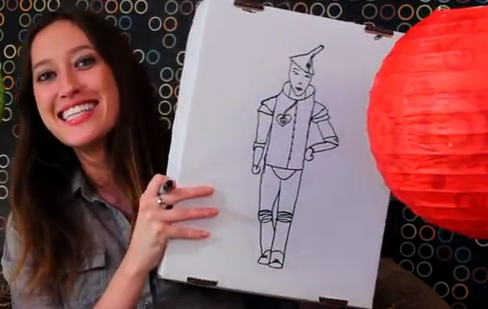O'Reilly's Make: Books launched a new series of books called DIY Science, and the first one is The Illustrated Guide to Home Chemistry Experiements, by Robert Bruce Thompson. Here's the preface to the book, which I found very inspiring.
Christmas morning, 1964. I was 11 years old. My younger brother and I arose at the crack of dawn and noisily rushed downstairs to find out what was under the tree. Our parents followed us, bleary-eyed.
Santa had been good to us that year. Colorfully-wrapped presents were scattered, not just under the tree, but across most of the living room floor. Being boys, we started tearing open the presents with no thought at all for the care that had gone into wrapping them. We were after the loot.
There were the inevitable disappointments. Sweaters from grandma, school clothes from Aunt Betty, and hand-knitted stocking caps for both of us from Pete and Sarah, our elderly next-door neighbors. But there was plenty of good stuff, too. Sports equipment and a cap pistol for my younger brother. A battery-powered Polaris nuclear submarine that actually fired small plastic missiles. A bicycle for my brother and a BB gun for me! Lots of books, the kind we both liked to read. A casting set, with a lead furnace and molds to make toy soldiers.
As we opened the packages, my brother and I mentally checked off items against our wish lists. We’d both gotten everything we asked for. Almost. One item had been at the top of every iteration of my wish list since the Sears Christmas Wish Book had arrived, and that item was nowhere to be found. I searched frantically through the piles of discarded wrapping paper, hoping I’d overlooked a box. It wasn’t there.
My parents had been watching my brother and me ripping through gifts like Tasmanian Devils. Just as I’d decided that I hadn’t gotten the one gift that I really, really wanted, mom and dad called me into the kitchen. There it sat, on the kitchen table, exactly what I’d been hoping for. It was already unboxed and spread wide open to show the contents. My father said, “This is from your mother and me. It is not a toy.”
It was a Lionel/Porter/Chemcraft chemistry set, and the exact model I’d asked for. The biggest one, with dozens of chemicals and hundreds of experiments. Glassware, an alcohol lamp, a balance, even a centrifuge. Everything I needed to do real chemistry. I instantly forgot about the rest of my presents, even the BB gun. I started reading the manual, jumping from one experiment to another. I carefully examined each of the chemical bottles. The names of the chemicals were magical. Copper sulfate, sodium carbonate, sulfur, cobalt chloride, logwood, potassium ferricyanide, ferrous ammonium sulfate, and dozens more.
I used the balance to weigh something for the first time. I put an object in one of the balance pans and carefully added weights to the other pan until the needle was centered. As I was about to jump on to something else, my dad brought me to a screeching halt. “Write it down,” he said. “A scientist records what he observes. If you don’t work methodically and write down what you observe, you’re not a scientist. You’re just playing around.” I’ve been recording my observations ever since.
I soon lost interest in the other gifts, but getting that chemistry set was a life-changing experience. My mother told me years later that she and my dad had hoped that the chemistry set would hold my interest for at least a few weeks. As it turned out, it held my interest a bit longer. With my dad’s help I built a chemistry workbench in the basement, and later a photographic darkroom. I scrounged equipment and chemicals from every source I could think of, and saved up for things that required cash money. I spent every spare moment in that lab, and went on to major in chemistry in college and graduate school. Even now, more than 40 years later, I have a chemistry lab in the basement. It’s a much better lab than the one I had back in the 1960s, but the work habits I learned then stand me in good stead now.
What I experienced that Christmas morning was repeated in millions of other homes through the years as boys (and, alas, only a few girls) opened their first chemistry sets. From the 1930s through the 1960s, chemistry sets were among the most popular Christmas gifts, selling in the millions. It’s said that in the 1940s and 1950s there was a chemistry set in nearly every household where there was a child. Even as late as the 1970s, chemistry sets remained popular and were on display in every toy store and department store. And then something bad happened. By the 1980s, chemistry sets had become a dying breed. Few stores carried them, and most of those sets that remained available were pale shadows of what chemistry sets had been back in the glory days.
The decline of chemistry sets had nothing to do with lack of interest. Kids were and are as interested as ever. It was society that had changed. Manufacturers and retailers became concerned about liability and lawsuits, and “chemical” became a dirty word. Most chemistry sets were “defanged” to the point of uselessness, becoming little more than toys. Some so-called “chemistry sets” nowadays are actually promoted as using “no heat, no glass, and no chemicals,” as if that were something to be proud of. They might just as well promote them as “no chemistry.”
Even the best chemistry set that is still sold, the $200 Thames & Kosmos Chem C3000, is an unfortunate compromise among cost, liability, and marketability. The Chem C3000 kit lacks such essential equipment as a balance and a thermometer, provides little glassware, and includes only the tiny amounts of chemicals needed to do unsatisfying micro-scale chemistry experiments. Despite these criticisms, the C3000 kit is a good choice for giving late elementary school or early middle school students their first exposure to hands-on chemistry lab work. It allows kids to produce bright colors and stinky smells, which after all are the usual hooks that draw kids into chemistry. The problem is, that’s not enough.
Laboratory work is the essence of chemistry, and measurement is the essence of laboratory work. A hands-on introduction to real chemistry requires real equipment and real chemicals, and real, quantitative experiments. No existing chemistry set provides anything more than a bare start on those essentials, so the obvious answer is to build your own chemistry set and use it to do real chemistry.
Everything you need is readily available, and surprisingly inexpensive. For not all that much more than the cost of a toy chemistry set, you can buy the equipment and chemicals you need to get started doing real chemistry. Of course, the main reason for that is the absence of the hidden liability surcharge. If you buy a chemistry set and burn yourself with the alcohol lamp, you might sue the maker of the chemistry set. If you buy an alcohol lamp by itself and burn yourself, you have no one else to blame.
So what about the very real dangers involved in serious chemistry lab work? After all, some of the experiments in this book use concentrated acids, flammable liquids, corrosives, and poisons. In one experiment we manufacture napalm, for heaven’s sake. Will readers of this book be dropping like flies, blowing themselves up, burning the house down, or growing extra arms? Of course not. Dangers can be dealt with. One of the recurring lessons throughout this book is the importance of assuming personal responsibility for useful but dangerous actions—understanding the specific risks and taking the necessary steps to minimize or eliminate them.
I set out to write this book after a conversation with our friend and neighbor Jasmine Littlejohn. At age 14, Jasmine is a bright kid who’s interested in science as a career. I asked her one day how much science she was learning in school. “Hardly any,” she replied. “On a typical day, we spend hours on math, social studies, English, and other stuff, and about 15 minutes on science.” Although Jasmine attends a good public school, like most schools it devotes little time and few resources to science and has only limited lab facilities. No doubt the school would plead money and safety concerns as reasons, but such excuses do nothing to help Jasmine.
With her mom’s approval, I could give Jasmine access to my basement chemistry lab, but that would solve only part of the problem. If Jasmine was to do more than make pretty colors and stinky smells, if Jasmine was to do real chemistry, she’d need more than just access to a lab. She’d need detailed instructions and some sort of structured plan to guide her through the learning process. She’d need to learn how to use the equipment and how to handle chemicals safely. She’d need well-designed experiments that focused on specific aspects of laboratory work. In other words, she’d need a home chemistry lab handbook, one devoted to serious chemistry rather than just playing around.
My first thought was to get Jasmine one of the classic home chemistry books published back in the 30s, 40s, or 50s. Some of those were excellent, but all of them required chemicals—such as benzene, carbon tetrachloride, salts of mercury, lead, and barium, concentrated nitric acid, and so on—that were once readily available but are now very expensive or difficult to obtain.
In one sense, that wasn’t really a problem. I already had most of that stuff in my lab. But even the best of those old books would have required some serious red-lining before I’d have turned Jasmine loose with it. One, for example, suggested tasting highly toxic lead acetate (also known as “sugar of lead”) to detect its sweetness. Others were a bit casual about handling soluble mercury compounds or contained experiments that were potentially extremely dangerous.
I concluded that the only good solution was to write a new book, one devoted to learning real chemistry at home, and one that would also be useful for the many thousands of other people out there—young people and adults—who wanted to experience the magic of chemistry just as I’d done on that long-ago Christmas morning, and to do so on a reasonably small budget with readily-available equipment and chemicals. And so Illustrated Guide to Home Chemistry Experiments was born.
Who This Book is For
This book is for anyone, from responsible teenagers to adults, who wants to learn about chemistry by doing real, hands-on laboratory experiments.
DIY hobbyists and science enthusiasts can use this book to master all of the essential practical skills and fundamental knowledge needed to pursue chemistry as a lifelong hobby. Home school students and public school students whose schools offer only lecture-based chemistry courses can use this book to gain practical experience in real laboratory chemistry. A student who completes all of the laboratories in this book has done the equivalent of two full years of high school chemistry lab work or a first-year college general chemistry laboratory course.
And, finally, a word about who this book is not for. If you want to make fireworks and explosives—or perhaps we should say if all you want to make is fireworks and explosives—this book is not for you. If your goal is to produce black powder or nitroglycerine or TATP, you’ll have to look elsewhere. Nor will you find instructions in this book for producing methamphetamine in your home lab or synthesizing other illegal substances. In short, if you plan to break the law, this book is not for you.
How This Book is Organized
The first part of this book is made up of narrative chapters that cover the essential “book learning” you need to equip your home chemistry lab, master laboratory skills, and work safely in your lab.
1. Introduction
2. Laboratory Safety
3. Equipping a Home Chemistry Lab
4. Chemicals for the Home Chemistry Lab
5. Mastering Laboratory Skills
The bulk of the book is made up of seventeen hands-on laboratory chapters, each devoted to a particular topic. Most of the laboratory chapters include multiple laboratory sessions, from introductory level sessions suitable for a middle school or first-year high school chemistry laboratory course to more advanced sessions suitable for students who intend to take the College Board Advanced Placement (AP) Chemistry exam.
6. Laboratory: Separating Mixtures
7. Laboratory: Solubility and Solutions
8. Laboratory: Colligative Properties of Solutions
9. Laboratory: Introduction to Chemical Reactions & Stoichiometry
10. Laboratory: Reduction-Oxidation (Redox) Reactions
11. Laboratory: Acid-Base Chemistry
12. Laboratory: Chemical Kinetics
13. Laboratory: Chemical Equilibrium and Le Chatelier’s Principle
14. Laboratory: Gas Chemistry
15. Laboratory: Thermochemistry and Calorimetry
16. Laboratory: Electrochemistry
17. Laboratory: Photochemistry
18. Laboratory: Colloids and Suspensions
19. Laboratory: Qualitative Analysis
20. Laboratory: Quantitative Analysis
21. Laboratory: Synthesis of Useful Compounds
22. Laboratory: Forensic Chemistry









